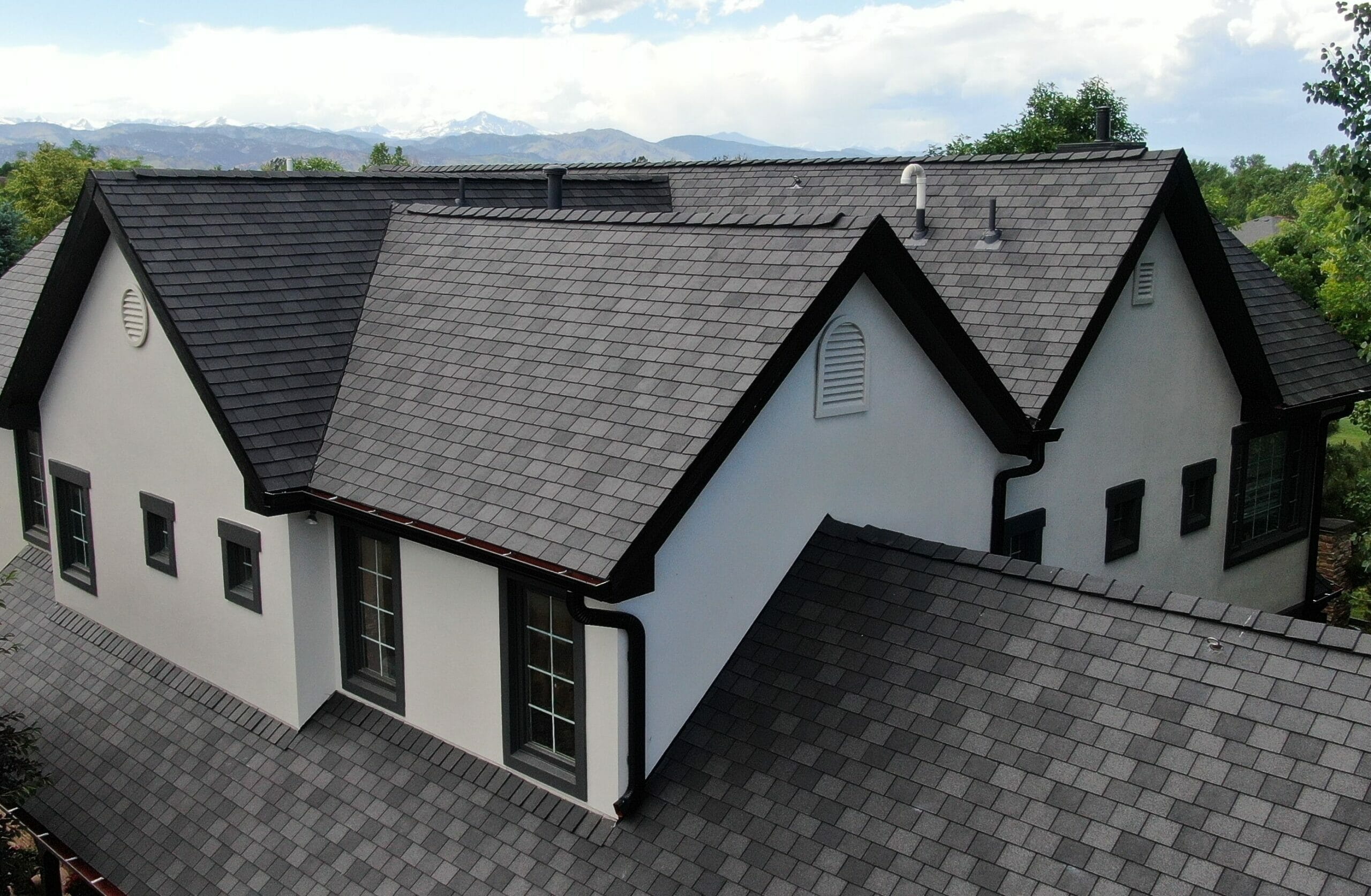
11 Oct Your Complete Guide To Slate Roofing
The Complete Guide to Slate Roofing – Once slate roofing was the preferred material for high-value roofs. As it was the best available material at the time, slate was used as the primary roofing material in many old churches and castles. Slate is still the preferred choice of those who seek the best. Even with all the new roofing materials available, slate still holds its place at the top of the pile. The unique advantages of slate roofing are what make it such a “primitive” material. These include safety, beauty, durability, insulation value, and safety.
Beauty
This is why high-end homeowners love this material. Natural stone’s look is unique and cannot be replicated in modern materials. This is why it remains a highly sought-after building material. You may have noticed that many commercial roofing shingles attempt to replicate the natural stone look. Fake stone may look half decent, but it is not the same as natural stone. Natural stone’s color and texture will enhance your roof’s beauty. You might be surprised at how many colors slate is available in. Although grey is the most popular color, slates can be found in a variety of colors. You can dye slate to create almost any color or pattern you desire, in addition to its natural colors.
Longevity
A slate roof has many advantages, not only because of its beauty but also because it is long-lasting. A slate roofing tile is made from stone and will withstand the elements for many thousands, if not millions of years. Did you know that all of the oldest monuments are made from stone? This is not an accident.
This type of roof is typically installed by roofing companies that offer a lifetime warranty. This material isn’t manufactured so they don’t have to worry about any manufacturer defects. A slate roof will last between one hundred and one hundred fifty years, unlike many other roofs that need to be repaired or maintained every ten years.
Slate is also able to withstand adverse weather better than other materials. This study will give you an idea of how it works. Researchers measured the bending strength for slate at different temperatures. To test if the stone’s flexibility could be modified, they subjected it to cycles of freezing and thawing. The stone would become more flexible if it was subjected to repeated freezing and thawing.
The stones developed micro-cracks which could eventually lead to breakage. But bear in mind, they were altering the weathering conditions of the stones much faster than natural processes. A hot glass that you took out of the dishwasher only to shatter when it was filled with cold water? This is the effect we’re referring to.
Insulation value
There are many materials that can be used to insulate your home against the outside elements. You can see old houses where the newspaper was used as insulation. This gives you an idea of the variety of materials that can be used to insulate a home.
But not all insulation materials are created equal. Although newspaper insulation doesn’t rank high on this list, it is definitely better than nothing. Slate on the other side has excellent insulation properties. It is almost impossible for cold or warm air to pass through slate roofs because it is dense and hard.
This will result in a higher level of comfort at home and a lower electric bill. The impact of your actions will determine how significant that reduction will be. It is difficult to predict what it will be. If your home and lifestyle aren’t energy-efficient, installing a slate roof won’t make any difference.
To achieve maximum insulation, stone walls and roofs will need some type of insulation. Despite being densely arranged stones making it difficult to penetrate, stones can still conduct heat and hold cold. Stone walls and roofs will let some heat and cold energy pass through without an additional barrier. They work well when they are combined with an underlayment.
Safety
Slate is a great roofing material for those who are concerned about fire hazards. Natural stone is the only material that does not catch fire. Slate can be cracked if heated enough, but this will only happen if the house is already in flames.
Slate is completely non-conductive. This means that electricity cannot travel through it. This reduces the risk of electrical hazards. Overall, slate is a safe material that should be considered by anyone who wants to take a closer look.
Drawbacks Of A Slate Roof
Despite all the great benefits, slate roofing isn’t widely used. These include cost, installation difficulties, weight, impact resistance, and cost.
Installation Problems
As we said, slate roofs aren’t used as often these days. This is because. There are fewer companies and contractors who know how to correctly install this material. It can be difficult to find the right contractor. You will most likely pay more for specialized services even if you find a great slate roof contractor. Because they don’t have as many opportunities to apply their skills, slate roof contractors are forced to charge more per job.
The worst part about this is that contractors may not be honest about their abilities and experience. Contractors won’t often tell you if they are qualified to install a slate roof. They don’t want your business to go under. They will likely tell you that even though their company has never had to do a single slate roof before, they are capable of doing the job.
Ask for references and see examples of previous work before you hire a roofing contractor. You should ensure that at least two previous slate roofing jobs are included in their portfolio. It is best to not ask them for slate jobs. A competent and experienced slate roofer should have that included in their portfolio. If they don’t have a portfolio or photos of slate roofs, you can walk away and look for another contractor.
Weight
If your home is structurally strong, slate is not the best roofing material. This is because slate is the heaviest roofing material available. It is likely that slate is not being used as much today due to its extra weight. A structure must be reinforced to withstand the additional weight of a stone roof.
We all know rocks are heavy. But how heavy do we really mean? Let’s find out the exact numbers. The handy material weight calculator should provide a good estimate.
Assuming that each tile measures a quarter-inch thick, is six inches in width, and is one foot in length, the shingle weighs 1.74 pounds. This is a lot of weight when you consider the number of shingles required to build a roof. Let’s compare the weight of an oak piece that is the exact same size. A shingle made from oak of this size would weigh approximately 0.5 pounds. Slate is almost as heavy as marble or granite altogether.
Impact Resistance
Slate is incredibly resistant to the weather but not so good at impact resistance. A sharp impact could cause damage to your stone tiles. The strange thing about the universe is that sometimes the hardest materials can be the easiest to fracture. The ancients knew that anything that is too hard will be difficult without being flexible, and slate rock is an excellent example of this fact.
This is a good thing because slate can withstand the impact of hailstones even large hailstones. This fact has been confirmed by studies. However, any hailstone larger than a hailstone will likely crack or break these roofing tiles.
Even the most careful roofer could accidentally step on some stones tiles and break them. Because they don’t have any flexibility, the weight of a person can cause them to crack, chip or split. Even worse, every slate tile is different in size and shape. This is because slate is often split along its natural grain. The grain is not always perfectly straight. This small variation between tiles makes it difficult to replace shingles.
Why Did Slate Become So Popular As a Roofing Material?
You might be asking yourself why slate was used for roofing tiles. Stone tile offers many advantages over other options, as we’ve already demonstrated. These benefits could be obtained from any type of stone. What made them choose slate over all other rocks?
Slate is much easier than other stones to break. All stone, like wood, has a grain structure that affects how it will break. Slate’s grain runs long ways along the stone’s length, just like a piece of wood. This is why it is possible to cut the stone into flat, small pieces the same way you would with a block.
Conclusion
Although slate roof tiles are not the best option for everyone, they offer unique and attractive benefits. A slate roof is a great choice if it’s well maintained. We recommend slate roofs over all other options if you have the money. You should still understand the pros and cons of each option before you make a decision. We hope you find this information helpful. We hope you contact us if you are looking for more information.



Sorry, the comment form is closed at this time.